Abstract
We demonstrate that poly(dA-dT) can adopt two conformations in solution, with the relative proportions dependent on the nature and concentration of the counter ion and cationic ligands. The synthetic DNA exhibits a dinucleotide repeat conformation on addition of CsF and Me4NCl at molar concentrations, with the NMR spectral changes reflecting a common conformational change at one glycosidic torsion angle and one phosphodiester linkage. We also observe the same dinucleotide repeat in the neighbor-exclusion 3 alpha, 17 beta-dipyrrolidin-1'-yl-5 beta- delta 9,11-androstene dimethiodide (3 alpha, 5 beta, 17 beta-dipyrandenium) complex, with the steroid diammonium ligand binding in the groove of the stacked poly(dA-dT) duplex and the complex stabilized through the interaction of one of the charged ends with the backbone phosphate. We demonstrate further that 3 alpha, 5 beta, 17 beta-dipyrandenium bound to poly(dA-dT) at low binding ratios induces a switch to the dinucleotide repeat conformation at adjacent steroid-free duplex regions. This observation contrasts with a previous demonstration that the diastereoisomeric 3 beta, 5 alpha, 17 beta-dipyrandium binds to poly(dA-dT) by partial insertion between unstacked tilted base pairs. The NMR parameters rule out a left-handed alternating DNA structure (Z DNA) for the observed poly(dA-dT) dinucleotide repeat conformation, but right-handed alternating DNA models are under consideration. The facile interconversion of poly(dA-dT) between two conformations, one of which exhibits a dinucleotide repeat and can be induced by ligand binding, may provide a mechanism for the recognition of specific nucleic acid sequences by DNA-binding proteins.
Full text
PDF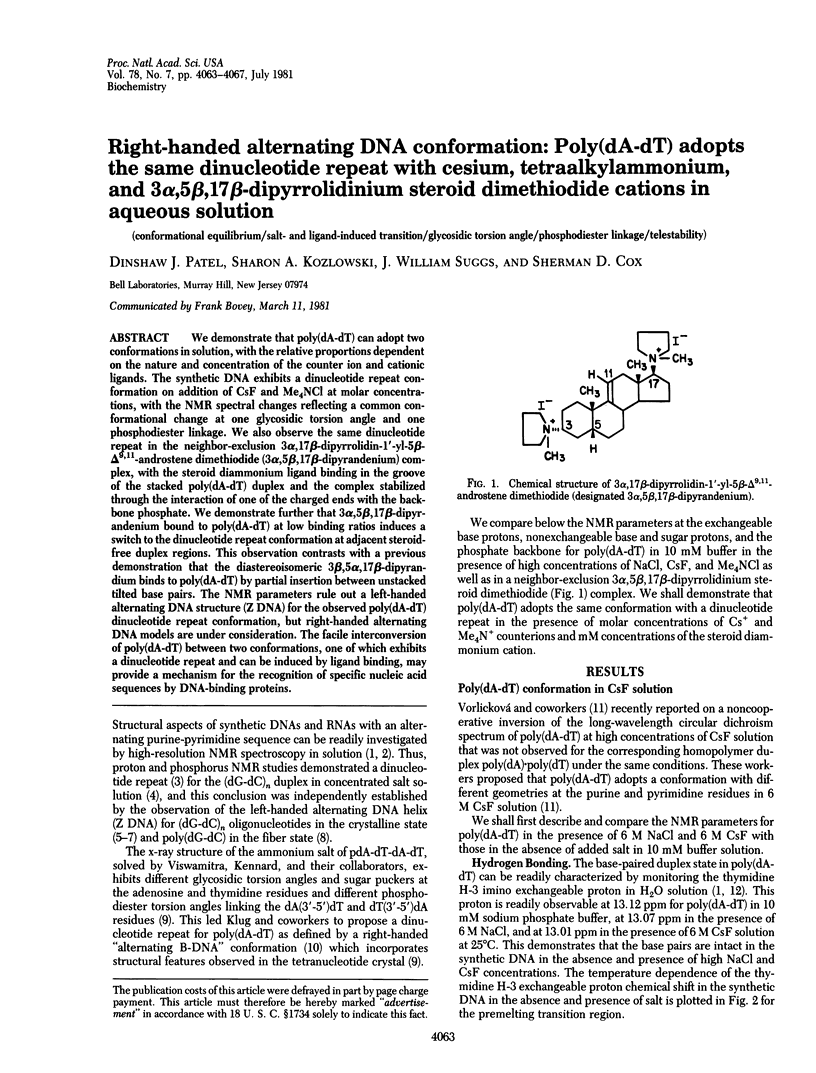
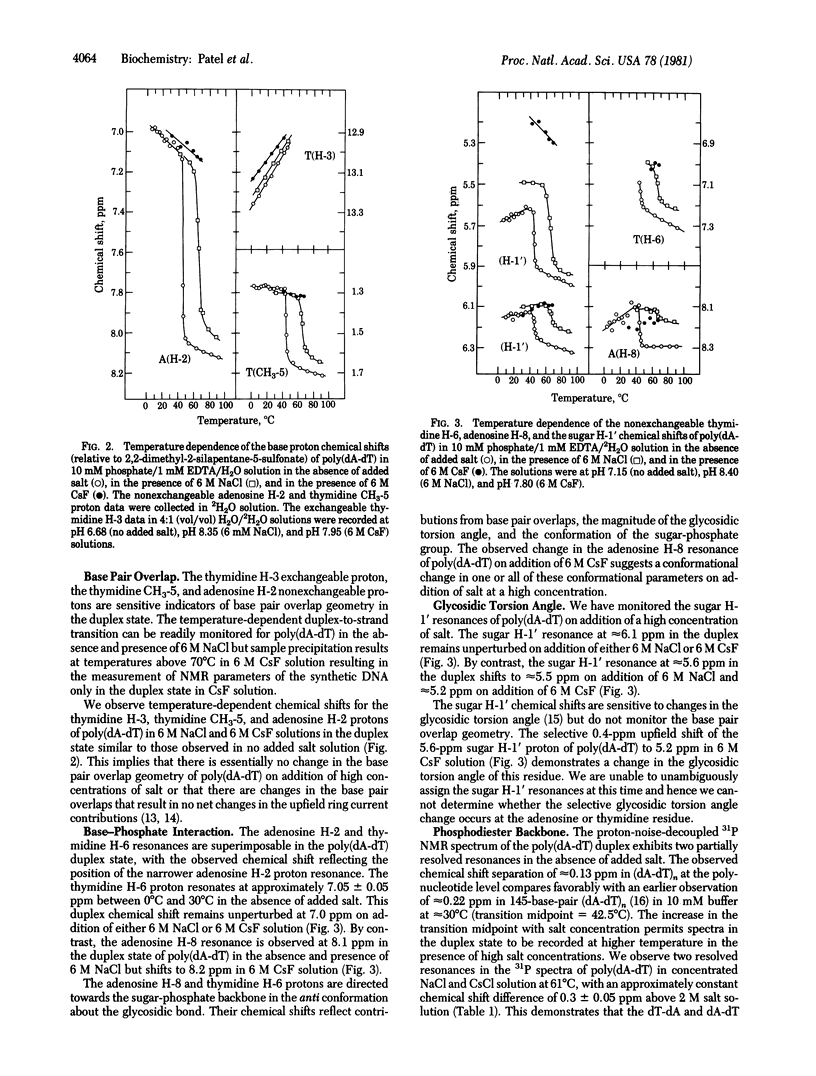
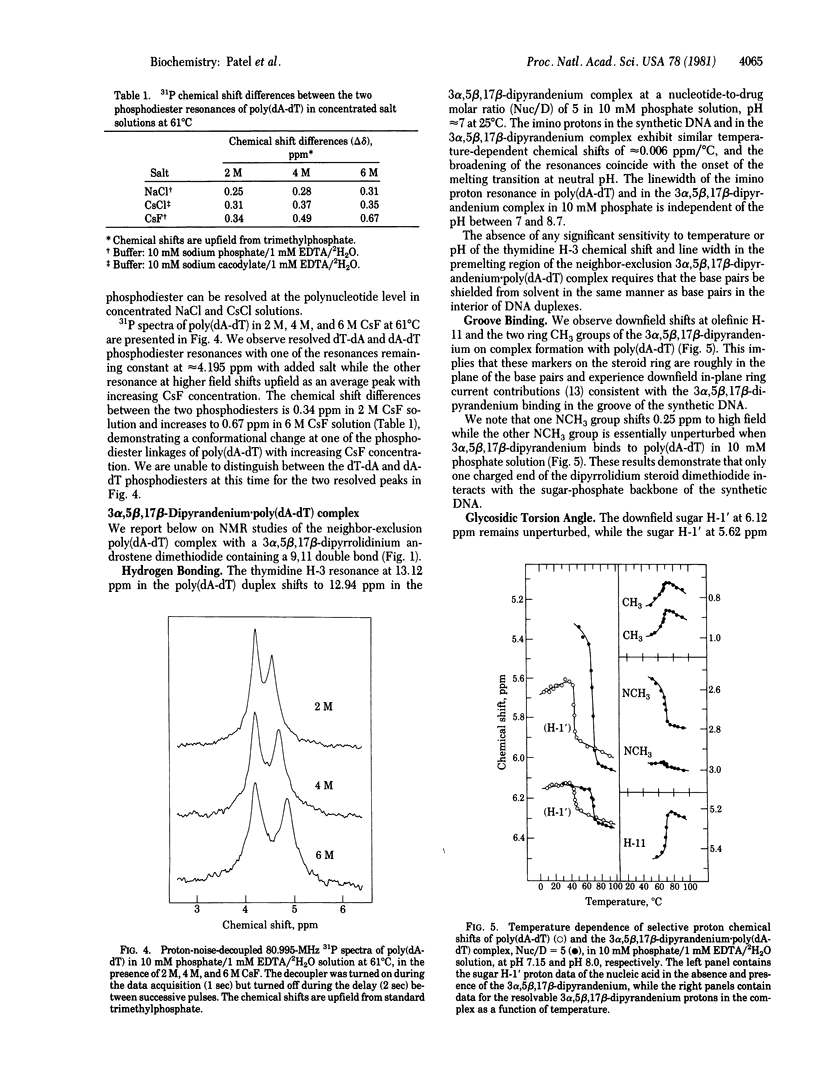
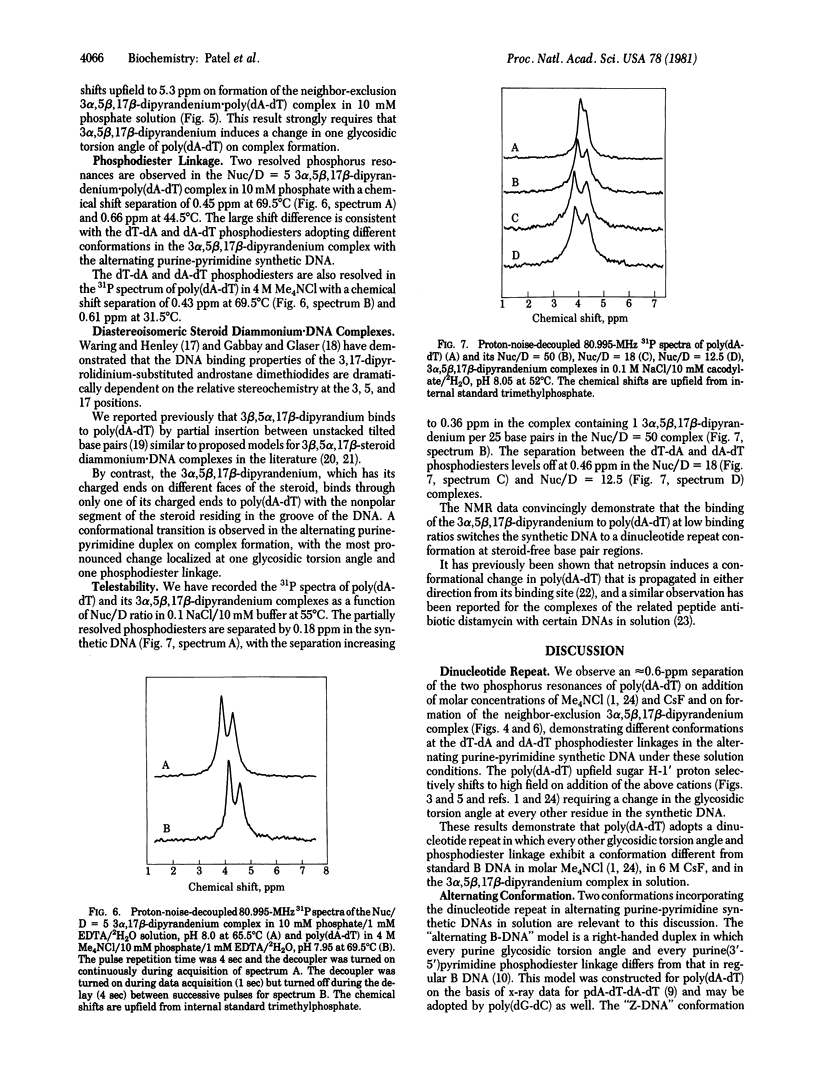
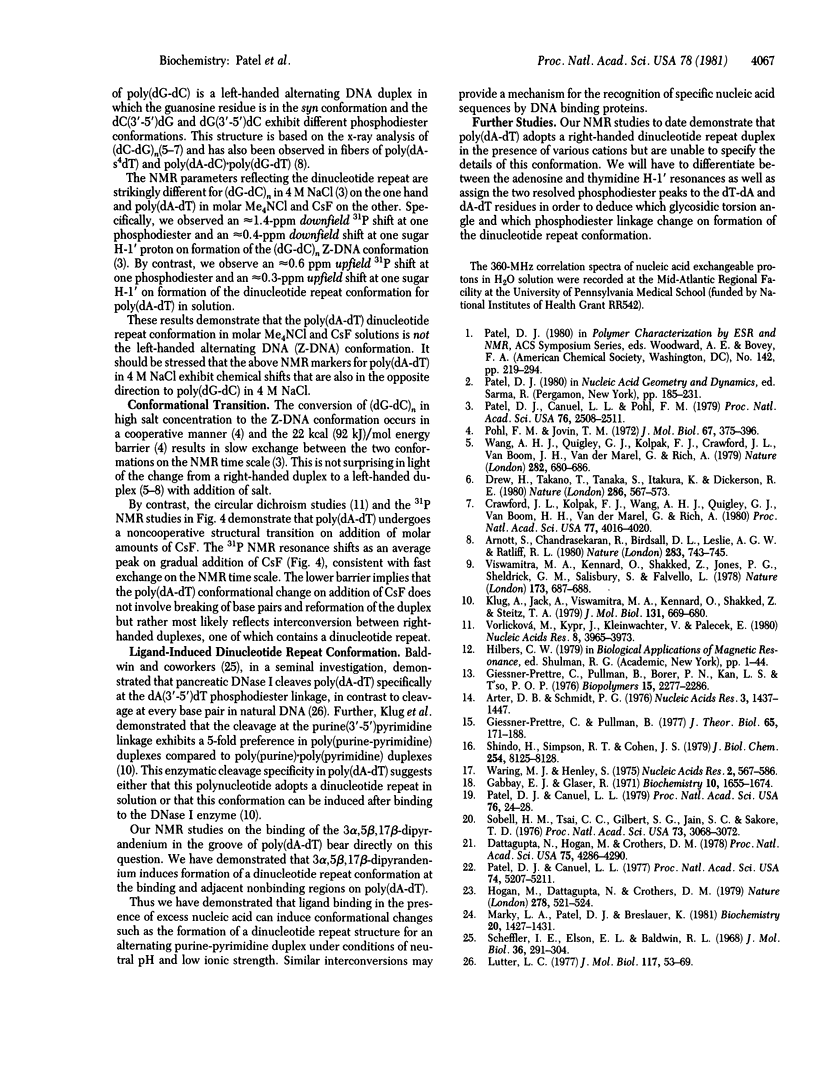
Selected References
These references are in PubMed. This may not be the complete list of references from this article.
- Arnott S., Chandrasekaran R., Birdsall D. L., Leslie A. G., Ratliff R. L. Left-handed DNA helices. Nature. 1980 Feb 21;283(5749):743–745. doi: 10.1038/283743a0. [DOI] [PubMed] [Google Scholar]
- Arter D. B., Schmidt P. G. Ring current shielding effects in nucleic acid double helices. Nucleic Acids Res. 1976 Jun;3(6):1437–1447. doi: 10.1093/nar/3.6.1437. [DOI] [PMC free article] [PubMed] [Google Scholar]
- Crawford J. L., Kolpak F. J., Wang A. H., Quigley G. J., van Boom J. H., van der Marel G., Rich A. The tetramer d(CpGpCpG) crystallizes as a left-handed double helix. Proc Natl Acad Sci U S A. 1980 Jul;77(7):4016–4020. doi: 10.1073/pnas.77.7.4016. [DOI] [PMC free article] [PubMed] [Google Scholar]
- Dattagupta N., Hogan M., Crothers D. M. Does irehdiamine kink DNA? Proc Natl Acad Sci U S A. 1978 Sep;75(9):4286–4290. doi: 10.1073/pnas.75.9.4286. [DOI] [PMC free article] [PubMed] [Google Scholar]
- Drew H., Takano T., Tanaka S., Itakura K., Dickerson R. E. High-salt d(CpGpCpG), a left-handed Z' DNA double helix. Nature. 1980 Aug 7;286(5773):567–573. doi: 10.1038/286567a0. [DOI] [PubMed] [Google Scholar]
- Gabbay E. J., Glaser R. Topography of nucleic acid helices in solutions. Proton magnetic resonance studies of the interaction specificities of steroidal amines with nucleic acid systems. Biochemistry. 1971 Apr 27;10(9):1665–1674. doi: 10.1021/bi00785a026. [DOI] [PubMed] [Google Scholar]
- Giessner-Prettre C., Pullman B., Borer P. N., Kan L. S., Ts'o P. O. Ring-current effects in the Nmr of nucleic acids: a graphical approach. Biopolymers. 1976 Nov;15(11):2277–2286. doi: 10.1002/bip.1976.360151114. [DOI] [PubMed] [Google Scholar]
- Giessner-Prettre C., Pullman B. On the conformational dependence of the proton chemical shifts in nucleosides and nucleotides. I. Proton shifts in the ribose ring of pyrimidine nucleosides as a function of the torsion angle about the glycosyl bond. J Theor Biol. 1977 Mar 7;65(1):171–188. doi: 10.1016/0022-5193(77)90082-0. [DOI] [PubMed] [Google Scholar]
- Hogan M., Dattagupta N., Crothers D. M. Transmission of allosteric effects in DNA. Nature. 1979 Apr 5;278(5704):521–524. doi: 10.1038/278521a0. [DOI] [PubMed] [Google Scholar]
- Klug A., Jack A., Viswamitra M. A., Kennard O., Shakked Z., Steitz T. A. A hypothesis on a specific sequence-dependent conformation of DNA and its relation to the binding of the lac-repressor protein. J Mol Biol. 1979 Jul 15;131(4):669–680. doi: 10.1016/0022-2836(79)90196-7. [DOI] [PubMed] [Google Scholar]
- Lutter L. C. Deoxyribonuclease I produces staggered cuts in the DNA of chromatin. J Mol Biol. 1977 Nov 25;117(1):53–69. doi: 10.1016/0022-2836(77)90022-5. [DOI] [PubMed] [Google Scholar]
- Marky L. A., Patel D., Breslauer K. J. Effect of tetramethylammonium ion on the helix-to-coil transition of poly(deoxyadenylylthymidine): a nuclear magnetic resonance and calorimetric investigation. Biochemistry. 1981 Mar 17;20(6):1427–1431. doi: 10.1021/bi00509a004. [DOI] [PubMed] [Google Scholar]
- Patel D. J., Canuel L. L. Netropsin-poly(dA-dT) complex in solution: structure and dynamics of antibiotic-free base pair regions and those centered on bound netropsin. Proc Natl Acad Sci U S A. 1977 Dec;74(12):5207–5211. doi: 10.1073/pnas.74.12.5207. [DOI] [PMC free article] [PubMed] [Google Scholar]
- Patel D. J., Canuel L. L., Pohl F. M. "Alternating B-DNA" conformation for the oligo(dG-dC) duplex in high-salt solution. Proc Natl Acad Sci U S A. 1979 Jun;76(6):2508–2511. doi: 10.1073/pnas.76.6.2508. [DOI] [PMC free article] [PubMed] [Google Scholar]
- Patel D. J., Canuel L. L. Steroid diamine-nucleic acid interactions: partial insertion of dipyrandium between unstacked base pairs of the poly(dA-dT) duplex in solution. Proc Natl Acad Sci U S A. 1979 Jan;76(1):24–28. doi: 10.1073/pnas.76.1.24. [DOI] [PMC free article] [PubMed] [Google Scholar]
- Pohl F. M., Jovin T. M. Salt-induced co-operative conformational change of a synthetic DNA: equilibrium and kinetic studies with poly (dG-dC). J Mol Biol. 1972 Jun 28;67(3):375–396. doi: 10.1016/0022-2836(72)90457-3. [DOI] [PubMed] [Google Scholar]
- Scheffler I. E., Elson E. L., Baldwin R. L. Helix formation by dAT oligomers. I. Hairpin and straight-chain helices. J Mol Biol. 1968 Sep 28;36(3):291–304. doi: 10.1016/0022-2836(68)90156-3. [DOI] [PubMed] [Google Scholar]
- Shindo H., Simpson R. T., Cohen J. S. An alternating conformation characterizes the phosphodiester backbone of poly(dA-dT) in solution. J Biol Chem. 1979 Sep 10;254(17):8125–8128. [PubMed] [Google Scholar]
- Sobell H. M., Tsai C. C., Gilbert S. G., Jain S. C., Sakore T. D. Organization of DNA in chromatin. Proc Natl Acad Sci U S A. 1976 Sep;73(9):3068–3072. doi: 10.1073/pnas.73.9.3068. [DOI] [PMC free article] [PubMed] [Google Scholar]
- Viswamitra M. A., Kennard O., Jones P. G., Sheldrick G. M., Salisbury S., Favello L., Shakked Z. DNA double helical fragment at atomic resolution. Nature. 1978 Jun 22;273(5664):687–688. doi: 10.1038/273687a0. [DOI] [PubMed] [Google Scholar]
- Vorlícková M., Kypr J., Kleinwächter V., Palecek E. Salt-induced conformational changes of poly(dA-dT). Nucleic Acids Res. 1980 Sep 11;8(17):3965–3973. doi: 10.1093/nar/8.17.3965. [DOI] [PMC free article] [PubMed] [Google Scholar]
- Wang A. H., Quigley G. J., Kolpak F. J., Crawford J. L., van Boom J. H., van der Marel G., Rich A. Molecular structure of a left-handed double helical DNA fragment at atomic resolution. Nature. 1979 Dec 13;282(5740):680–686. doi: 10.1038/282680a0. [DOI] [PubMed] [Google Scholar]
- Waring M. J., Henley S. M. Stereochemical aspects of the interaction between steroidal diamines and DNA. Nucleic Acids Res. 1975 Apr;2(4):567–586. doi: 10.1093/nar/2.4.567. [DOI] [PMC free article] [PubMed] [Google Scholar]


